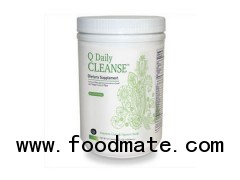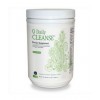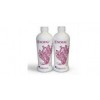Q Daily Cleanse
Reduce your toxin load and improve elimination. You’ll simply feel better, GUARANTEED!
Q’s Daily Cleanse is a unique and proprietary combination of high quality soluble and insoluble fibers, and a synergistic herbal blend to help maintain the health of your digestive system and colon. Our formula is unparalleled!
According to the American Dietetic Association, most Americans only consume 12-17 grams of fiber a day. Yet the recommended intake is 20-35 grams a day!
Q Daily Cleanse helps you to achieve your wellness goals by providing 8 grams of fiber PER SERVING. Why Take Fiber?
Everyone that has used Q Daily Cleanse agreed... once they experienced the benefits of this product, they never wanted to go a day without it. Find out what you've been missing, order today!
Q Daily Cleanse
Reduce your toxin load and improve elimination. You’ll simply feel better, GUARANTEED!
Q’s Daily Cleanse is a unique and proprietary combination of high quality soluble and insoluble fibers, and a synergistic herbal blend to help maintain the health of your digestive system and colon. Our formula is unparalleled!
According to the American Dietetic Association, most Americans only consume 12-17 grams of fiber a day. Yet the recommended intake is 20-35 grams a day!
Q Daily Cleanse helps you to achieve your wellness goals by providing 8 grams of fiber PER SERVING. Why Take Fiber?
Everyone that has used Q Daily Cleanse agreed... once they experienced the benefits of this product, they never wanted to go a day without it. Find out what you've been missing.
Q Daily Cleanse INGREDIENT REFERENCE GUIDE
PDR for Herbal Medicines- 4th Edition
Psyllium
-Laxative: psyllium decreases passage time of the bowel content by increasing the volume of stool, thus exerting a laxative effect. The herb acts as a stool softener by increasing stool water content. Psyllium was superior to ducusate sodium Colace in subjects with chronic idiopathic constipation.
-Anti-diarrhea: absorbs water from the gastrointestinal tract, adjusting the consistency of feces. Plantago major has antigiardiasic activity.
-Cholesterol- lowering effects: A decrease in LDL cholesterol and total cholesterol has been seen in many studies. Results with trigycerides and HDL cholesterol are mixed.
-Gallstone inhibiting effects: protects against cholesterol gallstone formation.
-Effects on Irritable Bowel Syndrome/Ulcerative Colitis: Stool frequency, consistency, abdominal pain, and abdominal distension have shown improvement in IBS patients.
Fibersol-2® soluable fiber glucose polymer complex: Not listed in the PDR/HM. Internet sources: Fibersol- 2® is a one–of-a-kind, readily dispersible, tasteless source of fiber with many beneficial physiological properties and a minimum of 90% dietary fiber. Fibersol-2 fiber content is unaffected by acid and heat. Totally soluble in water up to 70% at 20 C, allowing it to be solubilized in small amounts of water as needed.
Flax Seed Linum usitatissimum: Flaxseed is the richest known source of omega-3 fatty acids and lignans. Omega-3 fatty acids suppress the production of interleukin, tumor necrosis factor TNF and leukotriene B4 from monocytes and polymorpholymphocytes. Flaxseed appears beneficial in certain forms of insulin-resistant metabolic syndrome. Flaxseed has laxative effects from increased volume and consequent initiation of intestinal peristalsis from stimulation of stretch receptors.
Other effects: anti-inflammatory, anticancer, cardioprotective, metabolic syndrome, inhibition of cytokines, omega-3 fatty acid synthesis.
Fennel Seed Foeniculum vulgare: Promotes the stimulation of gastric motility and has an antispasmotic effect. Approved for peptic discomforts, such as mild, spastic disorders of the gastrointestinal tract, feeling of fullness, flatulence, catarrh of the upper respiratory tract.
Licorice root Glycyrrhiza glabra: Licorice has anti-inflammatory, antiulcer, and expectorant properties. It also has antiplatelet, antifungal, and antibacterial properties. Licorice has a long history of use for gastric ulcers. It may be effective for a variety of infectious diseases.
Aloe vera leaf: Effects include antibacterial, antifungal, anti-inflammatory, antineoplastic and laxative. As a laxative, Aloe is a colonic-specific stimulant that has a direct effect on the intestinal mucosa, increasing the rate of colonic motility, enhancing transit time, and inhibiting water and electrolyte secretion. In addition, the laxative effect is due to the irritation and stimulation of the colon. It may also have some stool softening properties. Studies demonstrate a laxative effect nine hours after ingestion.
Papaya fruit Carica papaya: Papain has antimicrobial, anthelmimic, and anti-ulcerative activity. Papaya has been used for wound-healing. There has been noted to be a hypoglycemic effect. Unproven uses for raw papain include gastrointestinal complaints, inflammations, and ulcers in the gastroduodenal area, and pancreas excretion insufficiency. Papaya leaves unproven uses have been for disorders of the GI tract with intestinal parasites.
Slippery elm bark Ulmus rubra: Slippery elm contains large amounts of mucilage, which will coat the surface of mucous membranes or the surface of wounds and sores when it comes in contact with water. It has been used as a demulcent and emollient. The primary indication for slippery elm is in the treatment of irritated and inflamed mucous membranes such as the lining of the throat and digestive tract. The mucilage works as a demulcent by soothing and decreasing the irritation of the intestinal tract, esophagus, and other mucous membranes.
PDR for Herbal Medicines- 4th Edition
Psyllium
Plantago ovata- Human studies have demonstrated psyllium’s laxative, cholesterol lowering, anti-hypertensive, and expectorant effects. Animal studies have shown anti-inflammatory, anti-neoplastic, cholesterol lowering, hypoglycemic, and hypotensive effects.
-Laxative: psyllium decreases passage time of the bowel content by increasing the volume of stool, thus exerting a laxative effect. The herb acts as a stool softener by increasing stool water content. Psyllium was superior to ducusate sodium Colace in subjects with chronic idiopathic constipation.
-Anti-diarrhea: absorbs water from the gastrointestinal tract, adjusting the consistency of feces. Plantago major has antigiardiasic activity.
-Cholesterol- lowering effects: A decrease in LDL cholesterol and total cholesterol has been seen in many studies. Results with trigycerides and HDL cholesterol are mixed.
-Gallstone inhibiting effects: protects against cholesterol gallstone formation.
-Effects on Irritable Bowel Syndrome/Ulcerative Colitis: Stool frequency, consistency, abdominal pain, and abdominal distension have shown improvement in IBS patients.
-Glucose Controlling Effects: Postprandial glucose and fasting plasma glucose significantly improved in type II diabetic patients.
Fibersol-2® soluable fiber glucose polymer complex: Not listed in the PDR/HM. Internet sources: Fibersol- 2® is a one–of-a-kind, readily dispersible, tasteless source of fiber with many beneficial physiological properties and a minimum of 90% dietary fiber. Fibersol-2 fiber content is unaffected by acid and heat. Totally soluble in water up to 70% at 20 C, allowing it to be solubilized in small amounts of water as needed.
Fibersol-2 is fermented slowly, thus producing less acid and gas than most soluble dietary fibers. 90% minimum DSB soluble dietary fiber (in accordance with AOAC method #2001.03 and one of the most economical fiber sources available. Fibersol-2, analytically and nutritionally, meets the definition of dietary fiber for nutrition labeling purposes, as published by the American Association of Cereal Chemists AACC and proposed by the National Academy of Sciences NAS.
Nopal Opuntia spp.: Not listed in the PDR/HM. See Book and Brochure by Dr. Ted Schock.
Black Walnut Leaf Jugulans nigra: Only Jugulans regia, named as Walnut is listed in the PDR/HM. It has Tannins and Flavonoids. Effects are listed as astringent and fungistatic. Unproven uses internally, include the use for gastrointestinal catarrh and as a blood purifier. Internet sources: antibacterial, astringent, antifungal, antiseptic, calmative.
Nopal Opuntia spp.: Not listed in the PDR/HM. See Book and Brochure by Dr. Ted Schock.
Black Walnut Leaf Jugulans nigra: Only Jugulans regia, named as Walnut is listed in the PDR/HM. It has Tannins and Flavonoids. Effects are listed as astringent and fungistatic. Unproven uses internally, include the use for gastrointestinal catarrh and as a blood purifier. Internet sources: antibacterial, astringent, antifungal, antiseptic, calmative.
Black Walnut Leaf is a remedy for sinus infection, hemorrhoids, liver and gallbladder problems. Leaf, bark and hull are each used to expel parasites, tapeworm and ringworm, and as a remedy for Candida albicans, and its mouth-centered affliction, oral candidiasis. Used as a laxative and as a blood cleanser.
Flax Seed Linum usitatissimum: Flaxseed is the richest known source of omega-3 fatty acids and lignans. Omega-3 fatty acids suppress the production of interleukin, tumor necrosis factor TNF and leukotriene B4 from monocytes and polymorpholymphocytes. Flaxseed appears beneficial in certain forms of insulin-resistant metabolic syndrome. Flaxseed has laxative effects from increased volume and consequent initiation of intestinal peristalsis from stimulation of stretch receptors.
-Digestive effects- flaxseed regulates the digestive tract by absorbing up to eight times its own weight in water and helping material move through the digestive tract. High mucilage content protects mucous membranes. Flaxseed may theoretically bind to toxic metabolites produced during digestion and may also reduce bloat.
Other effects: anti-inflammatory, anticancer, cardioprotective, metabolic syndrome, inhibition of cytokines, omega-3 fatty acid synthesis.
Fennel Seed Foeniculum vulgare: Promotes the stimulation of gastric motility and has an antispasmotic effect. Approved for peptic discomforts, such as mild, spastic disorders of the gastrointestinal tract, feeling of fullness, flatulence, catarrh of the upper respiratory tract.
-Unproven uses: In folk medicine, the herb was used for fish tapeworms, skin conditions, and for various eye complaints, including conjunctivitis.
Licorice root Glycyrrhiza glabra: Licorice has anti-inflammatory, antiulcer, and expectorant properties. It also has antiplatelet, antifungal, and antibacterial properties. Licorice has a long history of use for gastric ulcers. It may be effective for a variety of infectious diseases.
Modern use also focuses on hormonal issues, such as menopause and PMS.
-Approved uses include cough/bronchitis and gastritis.
-Approved uses include cough/bronchitis and gastritis.
-Unproven uses are for catarrh of the upper respiratory tract as well as for gastric/duodenal ulcers. In folk medicine, the
herb is used for appendicitis and constipation. It is also used for epilepsy and inflammation of the gastrointestinal and urogenital tract.
herb is used for appendicitis and constipation. It is also used for epilepsy and inflammation of the gastrointestinal and urogenital tract.
Aloe vera leaf: Effects include antibacterial, antifungal, anti-inflammatory, antineoplastic and laxative. As a laxative, Aloe is a colonic-specific stimulant that has a direct effect on the intestinal mucosa, increasing the rate of colonic motility, enhancing transit time, and inhibiting water and electrolyte secretion. In addition, the laxative effect is due to the irritation and stimulation of the colon. It may also have some stool softening properties. Studies demonstrate a laxative effect nine hours after ingestion.
Grapefruit pectin: Not listed in the PDR/HM. Internet resources say: Grapefruit Pectin is a rich, natural source of soluble fiber. Pectin may help maintain cholesterol levels already in the normal range and regulate blood sugar levels. Grapefruit itself is specifically link ed to helping to lower blood pressure as well as cholesterol. Grapefruit pectin is antibacterial. In addition, it is an antifungal agent and an antiparasitic.
Papaya fruit Carica papaya: Papain has antimicrobial, anthelmimic, and anti-ulcerative activity. Papaya has been used for wound-healing. There has been noted to be a hypoglycemic effect. Unproven uses for raw papain include gastrointestinal complaints, inflammations, and ulcers in the gastroduodenal area, and pancreas excretion insufficiency. Papaya leaves unproven uses have been for disorders of the GI tract with intestinal parasites.
Slippery elm bark Ulmus rubra: Slippery elm contains large amounts of mucilage, which will coat the surface of mucous membranes or the surface of wounds and sores when it comes in contact with water. It has been used as a demulcent and emollient. The primary indication for slippery elm is in the treatment of irritated and inflamed mucous membranes such as the lining of the throat and digestive tract. The mucilage works as a demulcent by soothing and decreasing the irritation of the intestinal tract, esophagus, and other mucous membranes.
Marshmallow root Althaea officinalis: It alleviates local irritation. Inhibits mucociliary activity, stimulate phagocytosis and functions as an anti-inflammatory and anticomplementary agent, immune stimulant and hypoglycemic. Approved uses: inflammation of the gastric mucosa and oral and pharyngeal irritation.Unproven uses: diarrhea and ulcers.
Rhubarb root: Not listed in the PDR/HM. Internet sources: Rhubarb Root is an ancient and gentle, but extremely effective, laxative. It supports good colon health by cleansing it and treating constipation, and in smaller doses, its astringents have eased diarrhea, bleeding and hemorrhoids. Rhubarb Root is considered a wonderful cleanser for the intestines, bowels, liver and blood, helping to rid the system of accumulated toxins. It is also an anti-microbial, antibacterial, and antibiotic and antiviral, and it may even help to improve digestion. The combination of Rhubarb Roots purgative and astringing properties make it an extremely effective colon cleanser. The purgative actions work to increase the motility of the colon pushing fecal matter through. This helps to clean out any impacted fecal matter that may have been building up. However, it's difficult for the contractions of the colon to completely clean the colon. The intestines in the digestive tract are very long and winding, therefore pockets of debris may be left behind. This is where the astringent action of Rhubarb Root is import ant. The astringent, tannin acid, comes after the purgative actions and does a thorough wash of the colon. Removing any left over pockets of fecal matter or infectious bacteria. Rhubarb Root has a purgative action for us in the treatment of constipation, but also has an astringent effect following this. It therefore has a truly cleansing action upon the gut, removing debris and then astringing with antiseptic properties as well.
Alfalfa leaf Medicago sativa: Cardiovascular, nervous and digestive system effects. Hypocholesterolemic effect-components synergistically bind bile acids required for cholesterol absorption from the gut. Moderate ability to lower serum cholesterol concentrations. May exhibit some hypoglycemic effects. Well documented antifungal activity. May have an enzymatic effect to decrease trypsin, chymotrypsin and lipase activity.
Guar Gum Cyamopsis tetragonoloba: Guar gum causes a lowering of postprandial serum glucose and has a lipid-lowering effect. Unproven uses include regulation of digestion. It has been used in Indian Medicine for night blindness, dyspeptic complaints, anorexia and constipation.
Peppermint leaf Mentha piperita: Peppermint has a spasmolytic effect on the smooth muscle of the digestive tract. It also has antiviral, antimicrobial, cholagogic and carminative as well as mild sedative effects. It is approved for cramp-like complaints of the GI tract as well as the gall bladder and bile ducts. Also, for symptomatic treatment of digestive problems including dyspepsia, flatulence, gastritis, and enteritis. Uva ursi leaf Arctostaphulos uva-ursi: astringent and antibacterial effects. Has urine sterilizing properties. Has been used as an adjunctive treatment for inflammatory conditions. May have antimicrobial effects on Escherichia coli and may possess bacteriostatic properties against Helobacter pylori.
Stevia Stevia rebaudiana: Stevia is a strong sweetening agent. Stevioside is 300 times as sweet as a 0.4% sucrose solution. Stevia may have antidiabetic and hypotensive effects









